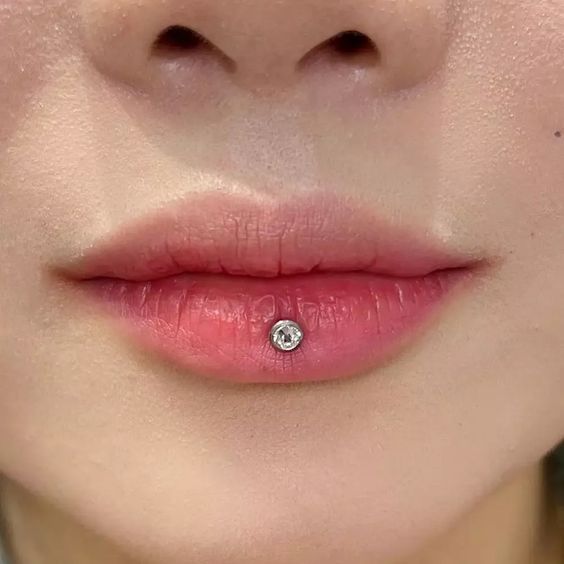Embodying a distinctive appearance by being one of the rare lip piercings positioned on the lip itself, the Ashley piercing complements vibrant lipstick choices with an alluring allure.
It’s an ideal piercing for individuals who boast beautiful lips and are well aware of it.
While bearing similarities to the vertical labret piercing—technically termed as the inverse vertical labret—the Ashley piercing distinguishes itself by showcasing the exit puncture inside the mouth rather than beneath the lip.
This unique placement offers a single-pierced aesthetic.
Enhanced with a simple bead, gemstone, or charm, the Ashley piercing delivers a minimalistic yet extraordinary look that draws positive attention.
However, being situated in an area prone to frequent movement and close to the mouth exposes the Ashley piercing to higher bacteria exposure than some other piercing types.
Consequently, diligent care is essential throughout the healing process. Here’s a comprehensive guide to navigate this aspect.
Origin of the Name “Ashley Piercing”

Image Credit: Pinterest
The name “Ashley piercing” for a single bottom lip stud piercing has an unconventional origin—it doesn’t have a specific source.
The naming of piercings often lacks a clear explanation, and in the case of the Ashley piercing, it is not linked to any particular individual named Ashley.
According to William Thompson, a professional piercer at Blacklisted Tattoo in Crown Point, Indiana, the names of many piercings, apart from their technical descriptions, remain shrouded in mystery.
Technically known as an inverted vertical labret, the Ashley piercing distinguishes itself by featuring only one visible point, fixed to the inner mouth, as opposed to the two visible points in a typical vertical labret.
As for the name “Ashley,” it appears to be an arbitrary designation with no specific connection to the origin or history of this distinctive lip piercing.
How Painful is Ashley Piercing?

Image Credit: Pinterest
Despite its placement on the sensitive lip, the Ashley piercing is generally associated with manageable pain levels.
Most individuals report experiencing a mid-level discomfort that quickly subsides.
While personal pain tolerance varies, a skilled piercer can assist by guiding through breathing exercises and ensuring a smooth and swift piercing process, minimizing discomfort.
Therefore, it is crucial to conduct thorough research to find a reputable piercer for your Ashley piercing.
Following the piercing, it’s normal to encounter some throbbing and swelling, a natural part of the healing process.
To accommodate this, your piercer will initially provide longer starter jewelry.
During the initial days, it’s essential to monitor the jewelry to prevent its ends from pressing against the piercing.
If this occurs, a visit to the piercer is necessary to switch to a larger jewelry piece.
As the swelling diminishes after a few days, transitioning to a smaller jewelry piece that sits flush against your lip is recommended.
This adjustment helps prevent accidental biting on the jewelry while eating.
Guidelines for Ashley Piercing Aftercare:

Image Credit: Pinterest
Due to its distinctive placement on the lips, the Ashley piercing requires meticulous aftercare practices.
While general principles for new piercings apply, the unique location makes adherence to these rules more challenging, given the piercing’s proximity to the lips.
- Handle with Care: Avoid excessive touching or movement of the new jewelry during the initial healing period to prevent trauma to the surrounding skin. This is particularly crucial for the Ashley piercing due to its location.
- Avoid Playing with the Jewelry: Despite its challenging location in the middle of the lip, refrain from playing with the jewelry, especially during the healing phase. Chewing on the lip as a nervous habit can lead to complications such as hypertrophic scarring or stretched puncture holes.
- Maintain Oral Hygiene: Given the exit hole inside the mouth, oral hygiene is vital. Carry a toothbrush and toothpaste to clean both the front and back of the piercing after meals, minimizing the risk of infection.
- Monitor Jewelry Tightness: Watch for signs of tightness in the jewelry, as swelling is common with the Ashley piercing. If you suspect tightness, consult your piercer promptly to determine if a larger piece is necessary.
- Protect Teeth: Be cautious of potential damage to teeth from the back of the jewelry rubbing against them during talking or chewing. Transitioning to a smaller stud as the piercing heals may reduce wear on the teeth, but continuous attention to enamel wear, chipping, or receding gum lines is essential.
- Postpone Lipstick Use: While the Ashley piercing pairs well with bold lip tones, refrain from using lipstick until the piercing is fully healed. Consult with your piercer before introducing foreign substances, as the inside of the piercing takes longer to heal than the outside.
- Dietary Considerations: Initially, opt for soft foods to minimize the risk of accidentally biting the new jewelry. Throughout the healing process, avoid acidic or spicy foods, as they can be painful for the piercing and may lead to irritation, scars, or piercing bumps.
- Choose Alcohol-Free Mouthwash: Avoid mouthwash with alcohol, as it can be painful and irritating to the piercing. Opt for alcohol-free mouthwash or rinse your mouth with a saline solution for a gentler approach to oral care.
Ashley Piercing Jewelry Options:

Image Credit: Pinterest
Exclusive to flat-back lip piercing jewelry, the Ashley piercing requires a flat back to minimize potential rubbing against gums and teeth, preventing complications.
Despite the limited styles available, there is room for creativity by exploring various jewelry ends, ranging from sleek and simple to opulent and extravagant.
Embrace larger gemstones for an attention-grabbing appearance, or opt for daintier labret stud ends for a cute and minimalist aesthetic.
Choose from a variety of options, including simple 14k gold balls, charming charms, dazzling gemstones like diamonds or opals, or delicate pearls.
The bezel setting stands out as an excellent choice for this piercing, allowing you to showcase a sparkly gemstone with a smooth and comfortable setting.
The minimalistic allure of the Ashley piercing makes it a favored complement to other lip piercings or even a septum or nostril piercing.
Choosing the Right Jewelry Material for Ashley Piercings:

Image Credit: Pinterest
When selecting jewelry for Ashley piercings, it’s essential to opt for inert metals that are unlikely to cause allergic reactions, advises Zeichner.
- Implant Grade Stainless Steel: This is a commonly used metal for jewelry, but it contains nickel, which may trigger allergic reactions in some individuals. Despite this, it is generally considered safe. If you’re confident you don’t have a nickel allergy, it can be a suitable choice.
- Gold: Gold enthusiasts should choose a metal with a karat of 14 or higher to ensure durability. Lower karat gold may be too soft and could harbor bacteria.
- Titanium: For those concerned about allergic reactions or irritation, titanium is a safe and reliable option. This metal is nickel-free, resistant to tarnishing, and lightweight, offering a worry-free experience.
- Pure Sterling Silver: Sterling silver is a popular choice, but it’s crucial to discuss it with your piercer. If it’s not the purest form of the metal, it might be too soft, similar to gold, potentially harboring bacteria.
How to Replace an Ashley Piercing?

Image Credit: Pinterest
Once your Ashley piercing has healed, downsizing is recommended by Gamble to ensure a more comfortable and permanent fit.
Starting with a slightly longer labret bar allows for initial swelling, but after the healing process, it’s crucial to switch to a shorter labret stud to enhance comfort and prevent rubbing against teeth.
After downsizing, you have the freedom to change the jewelry yourself. Simply unscrew the top part of the jewelry and screw on a new one.
It’s important to note that the fixed back of the jewelry, placed by your piercer, should not be removed.
This straightforward process allows for easy and personalized changes to your Ashley piercing.










